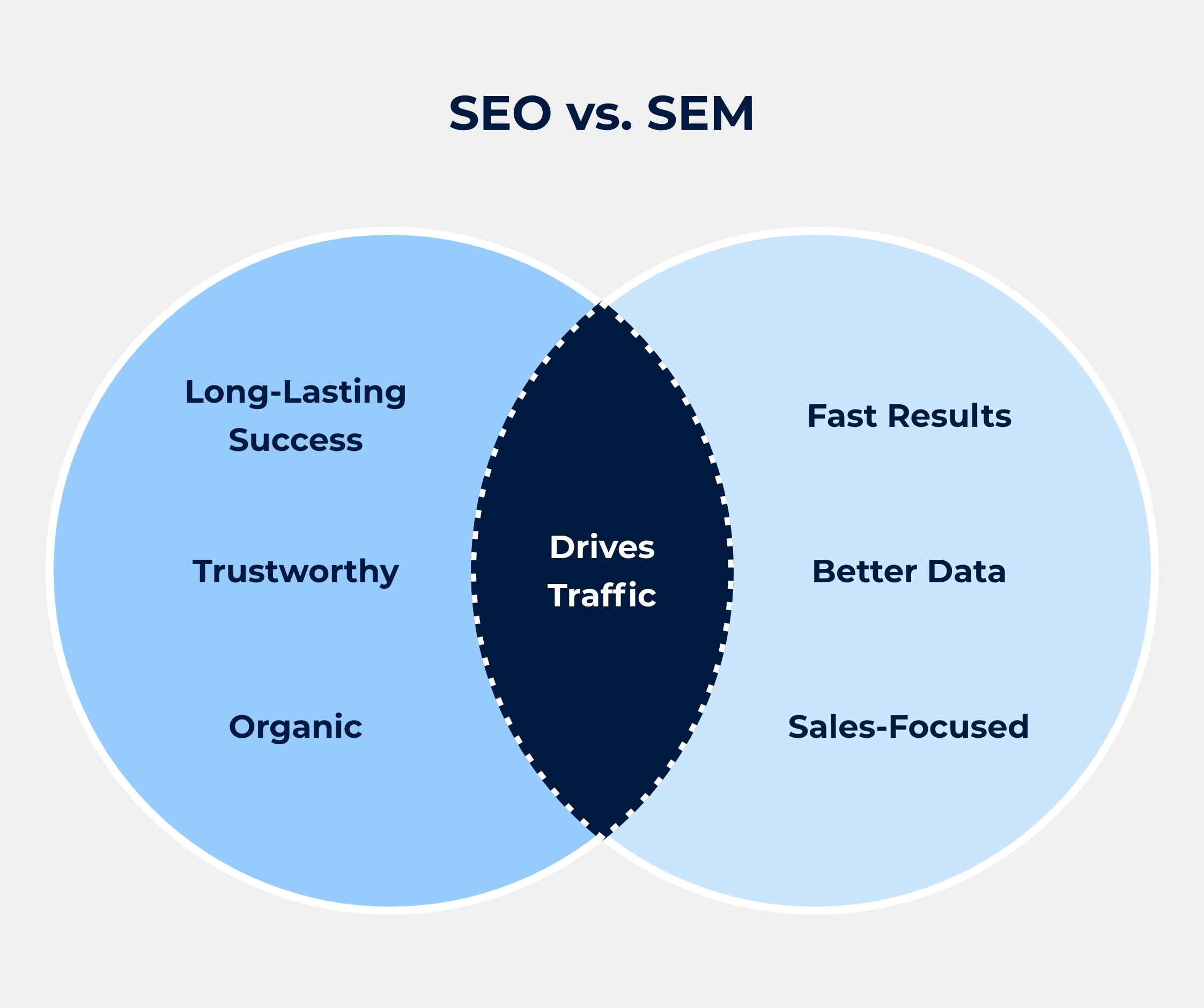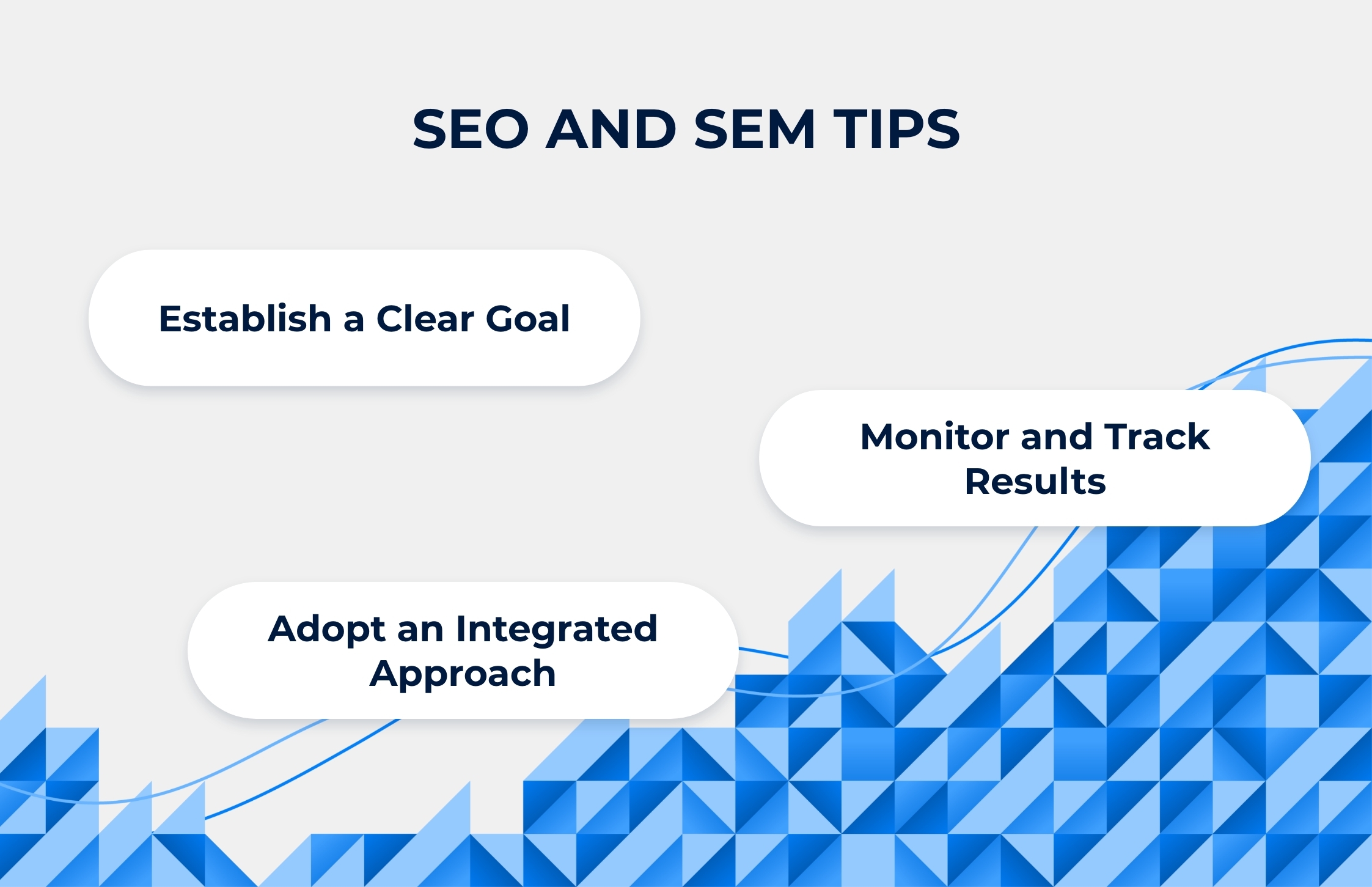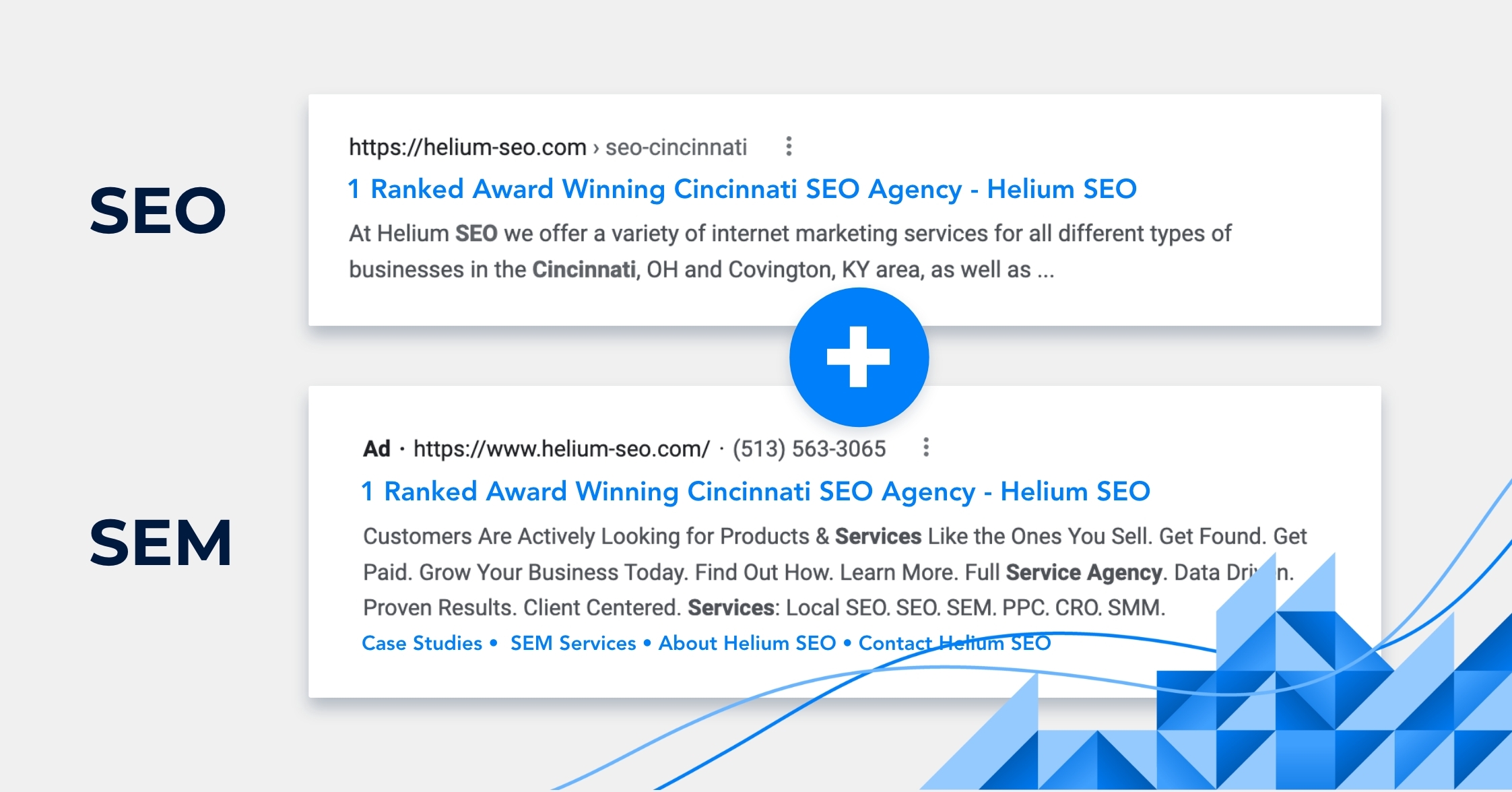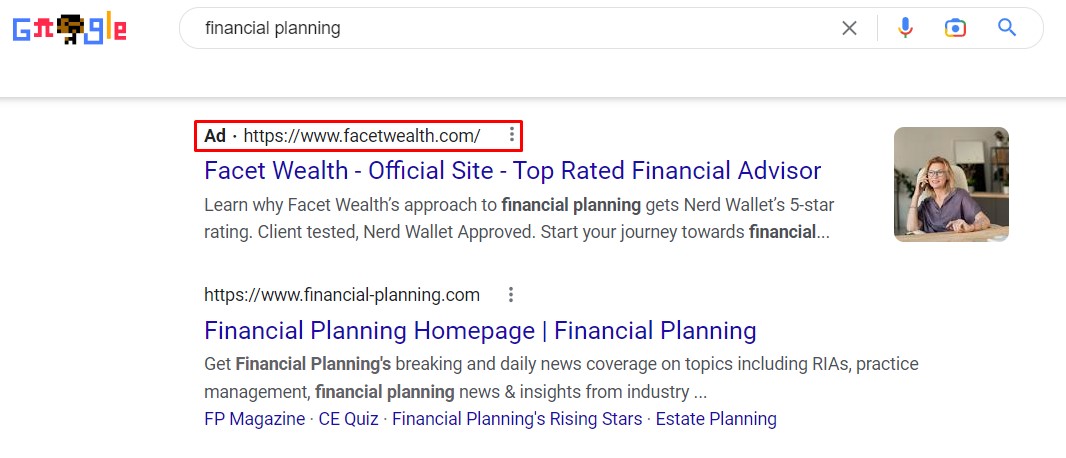In digital marketing, two strategies have become indispensable tools for achieving success—SEO (search engine optimization) and SEM (search engine marketing), which is also known as pay-per-click advertising. While both are distinct techniques that focus on different goals, they can be used together to maximize results for large and small businesses. We will explore how combining these powerful strategies can help marketers increase their ROI and achieve maximum success.
What Is the Difference Between SEO and SEM?
Search engine optimization is a digital marketing strategy that improves organic search engine rankings over time through content optimization and technical enhancements. This includes activities like keyword research, content outlining, on-page SEO (such as title tags, meta descriptions, headers, etc.), link building, as well as website structure and architecture.
On the other hand, search engine marketing is a paid approach to reach customers in the form of advertisements placed at the top of search results for specific terms or phrases. The goal of this method is to get immediate visibility and drive traffic to websites quickly.

What Are the Benefits of Using Both SEO and SEM?
Combining SEO and SEM has two main goals in mind: increasing visibility in search results and driving more qualified leads. By leveraging both strategies together, businesses can benefit from having an immediate presence in search engine results pages (SERPs) while also working toward long-term success through improved organic rankings.
Furthermore, allocating resources between SEO and paid ads gives marketers flexibility when it comes to budgeting; they are able to adjust spend according to what works best for their business and target market. This means they can focus more on SEM if they need to get immediate visibility or emphasize SEO for long-term growth. By using both tactics, marketers can create a comprehensive digital marketing strategy that will help them stay ahead of the competition and increase ROI.
Let’s dive in a little deeper.
SEO: The Long-Term Play
SEO is extremely important and a necessary asset in your digital marketing toolbelt. The main downside of SEO is that it takes time to achieve success. There is a lot of upfront research, content writing, link building, and ongoing optimizations. A typical SEO campaign will take 9-12 months to start seeing a positive return on your investment. However, the long-term ROI is definitely worth the wait.
Unfortunately, there are many situations where that 9-12 month runway for SEO results is just too long. This is where SEM can jump in and take some pressure off of SEO.
SEM: Let’s Get Leads, Now
I am not going to tell you that you can create a couple of Google Ads campaigns, put in some keywords, write ad copy, and you will immediately start seeing results; it’s simply not the case.
SEM, like SEO, has a very detailed, specific process that must be followed if you expect to have any ROI at all. However, the benefit of SEM is that once you understand the objectives, do initial research and strategically build out the campaigns, you can start seeing leads come in within the first month. Even though you are seeing leads come through, it often still takes time to make adjustments to generate the right leads at the right CPL (cost per lead).
Running successful SEM campaigns takes consistent effort and optimizations to maximize ROI. It is not a “set it and forget it” type of marketing strategy.
Want Advice to Best Manage Your SEO and SEM Strategies?
Get monthly insights on SEO, SEM, and CRO that drive results.
It All Starts with Keyword Research
A couple of weeks ago, we released a blog focused entirely on defining keyword research because it is the cornerstone of any SEO strategy. SEO results can live or die in this part of the process. In that blog post, we cover why it’s so important, but also how to conduct keyword research.
When performing keyword research for SEO, we identify each keyword as either a:
- Good keyword, meaning we can rank for that term within 9-12 months.
- Long-term keyword, meaning it will most likely take longer than 9-12 months to rank, but still obtainable.
- Keyword out of reach, either due to the intent of the keyword or the competition that is currently ranking for that keyword is too strong for our target site to compete.
We also need to analyze the intent of each keyword. Some keywords are toward the top of the funnel, meaning they are more likely to generate clicks but not leads. Other keywords are transactional, meaning that they are keywords that will generate more leads.
An effective SEO strategy leverages both informative, top-of-the-funnel keywords, as well as very high-converting transactional keywords. The goal of SEO is always positive ROI, but it is also having the largest search visibility possible. The keywords toward the top of the funnel oftentimes have the largest search volume which allows us to maximize our reach, while keywords lower in the funnel receive much less search traffic, but convert at a much higher rate.
On the paid ads side of the equation, we want to focus on as many keywords lower in the funnel as possible. We are spending money on each click so we need to make sure that each keyword has the largest potential to convert as possible.
Using this research we can strategically delegate keywords to either be part of an SEO campaign, an SEM campaign, or sometimes both. If there are keywords that will take a longer timeframe to rank organically or are out of reach, it will often make sense to target those keywords in our SEM campaigns so that we can capitalize on that traffic sooner.
Stay Top of Mind
When you are investing in SEO and SEM, adding in remarketing campaigns is a must. There is a good chance that a majority of your visitors are not going to convert on the first visit to the website. (In fact, the average conversion rate for a site is only between 1 and 3 percent.) Generally, we see people who may visit a site from a paid ad, then visit again from organic search, and may even visit a 3rd or 4th time. One way to stay top of mind is by adding remarketing to your paid ad campaigns.
Remarketing is serving targeted ads to people who have already visited a website. So, for example, setting up remarketing rules to only remarket to users who didn’t fill out a form is a great way to influence more repeat visitors and—ultimately—more conversions. You can also use these rules to promote certain specials or deals on your site based on the specific pages they navigate to.
The good news about remarketing is that it’s fairly cheap compared to a normal search campaign, meaning that your CPL could be extremely low.

Tips to Maximize the Results of SEO and SEM
- Establish a Clear Goal – Before starting any digital marketing efforts, it’s important to establish a clear goal that you are trying to achieve. This could be anything from increasing website visibility in search results to driving more qualified leads to the site. Once you have established a goal, you can use this as the basis for determining what tactics should be used and how resources should be allocated between SEO and SEM.
- Adopt an Integrated Approach – When combining SEO and SEM, it’s important to take an integrated approach by using complementary tactics that work together in order to maximize results. For example, leveraging keywords identified through keyword research for both SEO and SEM campaigns can help ensure that the same message is communicated across all channels.
- Monitor & Track Results – Finally, it’s important to monitor and track the results of your digital marketing efforts in order to assess which strategies are working best and where improvements could be made. This includes tracking metrics such as website traffic, conversions, bounce rate, time on site, etc., so you can adjust your strategy accordingly.
Final Thoughts
Combining SEO and SEM is a great way for businesses to achieve success with their digital marketing efforts. By leveraging both strategies together, businesses can benefit from having an immediate presence in SERPs while also investing long-term for higher organic results. Additionally, combining these two strategies allows businesses to better target their audience with relevant content that speaks directly to their needs.
By following the tips outlined above and creating an integrated approach between SEO and SEM, companies will be able to maximize their ROI and stay ahead of the competition.
Let Helium SEO Help Your SEO & SEM Campaign
Managing either an SEO or SEM campaign by itself can be often be too overwhelming for business owners, website manages, or marketers. It requires significant digital expertise, implementation knowledge, software for proper tracking, and then the time and energy to continually adjust your approach. But managing both an SEO and SEM campaign in-house typically leads to frustration, decreased results, and eventually wasted time and money.
Let us be your all-in-one team for organic SEO services and paid SEM services. Get in touch with us today to find out how we can elevate your digital presence.
Frequently Asked Questions (FAQs)
What is SEO and SEM?
SEO (search engine optimization) is the practice of getting traffic from organic search results; on the other hand, SEM (search engine marketing) is the practice of getting traffic from paid ads that appear in search results or on websites.
Is SEM or SEO Better?
The benefits of SEO and SEM depend on what you’re looking for. If you want long-term success and brand trustworthiness, then SEO is the way to go. But if you want faster results, more data on hand, and lead-focused clicks, then SEM is the way to go.
Can SEO work with SEM?
Not only can SEO and SEM work together, but it’s encouraged for them to work in tandem. You can utilize SEO for long-term investments while building your site’s credibility and presence while also using SEM for quicker results for more sales-focused terms.
How do you use SEO and SEM Together?
It’s recommended to always be focused on SEO for your entire site. Every page should target a specific keyword and be optimized to compete for that keyword. Then, you can use SEM to target (and hopefully convert on) more sales-focused keywords. Letting SEO and SEM work hand-in-hand yields the best results.
What Is an SEO Strategy?
An SEO strategy is optimizing your website to rank better for keywords your target audience is searching. This includes keyword research, content outlining, writing, link building, etc. A good SEO strategy will drastically improve your organic traffic and yield long-lasting results.
What Is a Good SEM Strategy?
A good SEM strategy revolves around getting visitors to convert on what your page is offering. Because you’re paying for each click, you want to make sure that visitors will be enticed to make a purchase so your campaign isn’t a sunk cost. This strategy boils down to keyword research, forming ad groups, creating ads, and then optimizing your landing page for conversions. What makes the strategy even more successful is frequent testing and adapting based on results.








